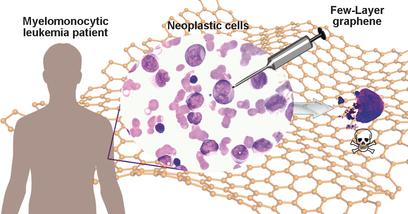In the cure of cancer, a major cause of today's mortality, chemotherapy is the most common treatment, though serious frequent challenges are encountered by current anticancer drugs. We discovered that few-layer graphene (FLG) dispersions have a specific killer action on monocytes, showing neither toxic nor activation effects on other immune cells. We confirmed the therapeutic application of graphene on an aggressive type of cancer that is myelomonocytic leukemia, where the monocytes are in their malignant form. We demonstrated that graphene has the unique ability to target and boost specifically the necrosis of monocytic cancer cells. Moreover, the comparison between FLG and a common chemotherapeutic drug, etoposide, confirmed the higher specificity and toxicity of FLG. Since current chemotherapy treatments of leukemia still cause serious problems, these findings open the way to new and safer therapeutic approaches.

In the cure of cancer, a major cause of today's mortality, chemotherapy is the most common treatment, though serious frequent challenges are encountered by current anticancer drugs. We discovered that few-layer graphene (FLG) dispersions have a specific killer action on monocytes, showing neither toxic nor activation effects on other immune cells. We confirmed the therapeutic application of graphene on an aggressive type of cancer that is myelomonocytic leukemia, where the monocytes are in their malignant form. We demonstrated that graphene has the unique ability to target and boost specifically the necrosis of monocytic cancer cells. Moreover, the comparison between FLG and a common chemotherapeutic drug, etoposide, confirmed the higher specificity and toxicity of FLG. Since current chemotherapy treatments of leukemia still cause serious problems, these findings open the way to new and safer therapeutic approaches.
